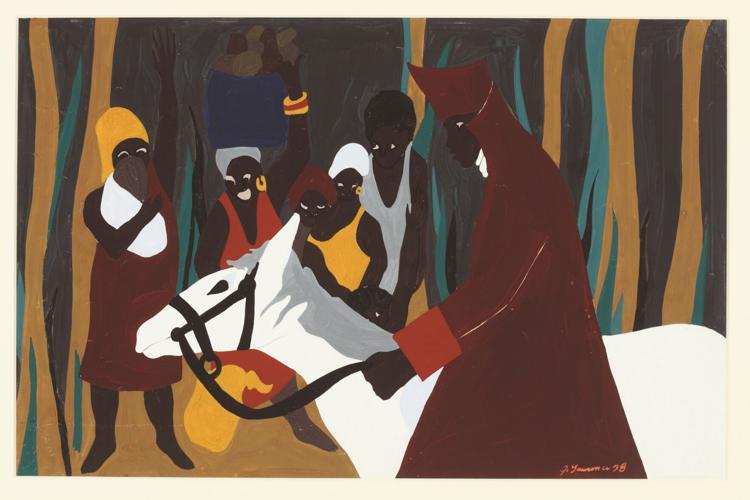A New Orleans research center has received $1 million to conserve 41 paintings by Jacob Lawrence, one of the most important American artists of the 20th century.
The three-year grant to the Amistad Research Center from the Terra Foundation for American Art will underwrite a project to analyze and preserve a series of paintings by Lawrence (1917-2000) depicting the 1791 revolution of enslaved people that Toussaint L’Ouverture led against French rulers of the Caribbean island of Saint-Domingue (now shared by Haiti and the Dominican Republic).

Lawrence, Jacob. Toussaint L'Ouverture Series, no. 34, Toussaint defeats Napoleon's troops at Ennery, 1938. (Courtesy of the Amistad Research Center)
The subject of Lawrence’s art was born into slavery in 1743 but was legally freed and led the Haitian independence movement during the French Revolution. He was a skillful military leader whom Napoleon perceived as a threat. He suspected L'Ouverture of plotting an uprising and ordered his arrest. L'Ouverture died in prison in 1803.
Finally, paintings on public view
The paintings, which Lawrence completed in 1938 at the age of 21, have not been seen publicly since 2010, when they were on view at the New Orleans Museum of Art. Preserving them will take time because the process entails a scientific analysis of each painting and its components, such as the paint and paper, said Kathe Hambrick, the center’s director.
When the conservation process is complete, they will travel to three museums. Those sites have not been selected, she said, and the images cannot be released until the restoration, at the Conservation Center for Art & Historic Artifacts in Philadelphia, is complete.

Kathe Hambrick, executive director of Amistad Research Center, and Heather Hendry, senior paper conservator at the Conservation Center for Art and Historic Artifacts, in Philadelphia.
The paintings’ conservation and subsequent tour represent “a very, very significant historical, cultural and artistic opportunity for us to educate the world about Haiti and France,” Hambrick said. She spoke from Paris, where she is on a Terra Foundation-sponsored trip to learn about the interpretation of slavery through the arts and tourism.
The foundation, a private, nonprofit organization, supports American art exhibitions, projects, research and publications.
The Amistad Center is on Tulane’s Uptown campus. Its mission is to collect, preserve and provide access to original materials about the social and cultural importance of America's ethnic and racial history, the African Diaspora, human relations and civil rights, its website explains.
Drawing on everyday Black life
Jacob Lawrence, who started art classes in his youth, was one of the first artists trained in and by the African American community in Harlem. Drawing on everyday Black life for his paintings, he used vivid colors and crisp images in a style that he described as “dynamic cubism.”

Jacob Lawrence's 1964 painting 'Four Sheep,' is a lush impression of marketplace ritual.
He achieved an audience through the work of the Harmon Foundation, which was founded in 1921 to showcase the work of Black artists.
In a 1938 essay for an exhibition at the Harlem YMCA, Lawrence’s teacher, Charles Alston said his student had “achieved a richness and brilliance of color harmonies both remarkable and exciting ... Lawrence symbolizes more than anyone I know, the vitality, the seriousness and promise of a new and socially conscious generation of Negro artists.”
Members of the arts community recognized the significance of Lawrence’s L'Ouverture series early on. In 1939, when the paintings were exhibited at the Baltimore Museum of Art, Alain Locke, a writer and philosopher on the Howard University faculty, described them as “one of the most important” and “symbolic” works of their time, Gary A. Reynolds wrote in “Against the Odds: African American Artists and the Harmon Foundation.”
Talent and connections
In addition to talent, Lawrence had connections, most notably with Mary Beattie Brady, the Harmon Foundation’s director. Starting in 1927, that foundation did an annual “Exhibition of the Work of Negro Artists.”
One of Lawrence’s most notable works was “The Migration of the American Negro,” whose 60 panels document the exodus of African Americans from the rural South to the urban North.
Lawrence’s importance was cemented when he became the first African American painter whose work became part of the collection of the Museum of Modern Art in New York City.
So how did the L'Ouverture series get to New Orleans?
After those paintings were shown in Baltimore in 1939, the Harmon Foundation acquired them. When that foundation ceased operations in 1967, its holdings were dispersed.
Among the recipients was the Amistad Center, which had been founded in 1966 at Fisk University in Nashville, Tennessee. In 1969, the center moved to New Orleans, first to Dillard University and, in 1987, to Tulane.
The prospect of having the restored paintings on view once more will represent “a very, very significant historical, cultural and artistic opportunity for us to educate the world,” Hambrick said.















